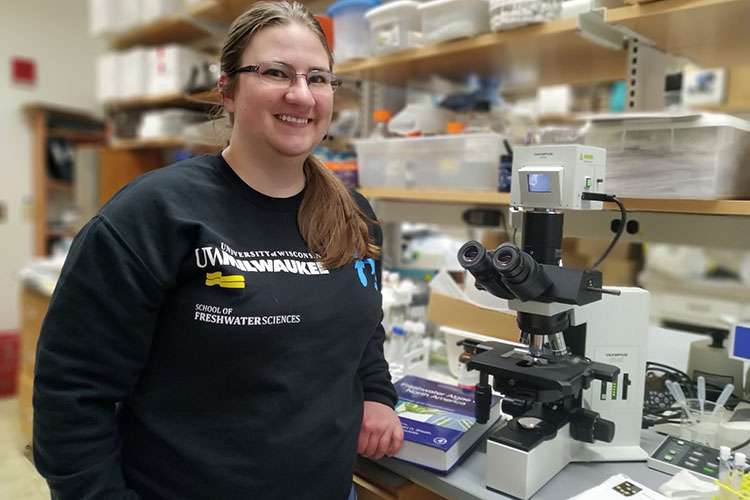“I’ve always been the bug girl,” says Amy Ressel.
As a kid, Ressel wanted microscopes and bug boxes for Christmas. After high school, she served in the Air Force and then worked as a maintenance mechanic at Mitchell International Airport.
Amy Ressel, UWM undergraduate, is researching diatoms at the School of Freshwater Sciences.
Now a student in UWM’s School of Freshwater Sciences undergraduate program, the 32-year-old military veteran is using a microscope to study diatoms, single-celled algae whose cell walls are made of silica, the same substance that makes up glass. They are critical to aquatic food webs and remove carbon dioxide from the atmosphere.
Ressel had never heard of diatoms until she and her classmates went on the R/V Neeskay, the School’s primary research vessel. The research experience was part of the Freshwater 120 course.
“I was like a little kid in a candy store,” she says. “To go out and play in the water and take the samples and see how all the scientific equipment worked, it was by far the highlight of my first semester.”
The Neeskay expedition was designed to give students a taste of what freshwater research is like. During the trip, SFS senior scientists Drs. Carmen Aguilar and Russell Cuhel talked about their decades-long research on Lake Michigan and the three rivers that feed into it — the Milwaukee, Kinnickinnic and Menomonee.
Students learned how to collect and prepare samples from the rivers and Lake Michigan. They also conducted a measurement that can trace movement of minerals, including salts, through the rivers, harbors and into Lake Michigan. The students’ samples are now part of 30-years of data collected from the local waterways.
“That empowers students to know they are doing something that is meaningful in a bigger context,” Cuhel says.
One of the goals of the undergraduate program is to provide experiential opportunities every semester. This fall, Aguilar and Cuhel will teach a new “Life in Water” course during which students will have more opportunities to go on the Neeskay. During these expeditions, students will conduct measurements and learn about local waters.
Aguilar notes that getting students on the Neeskay early in their degree program shows them what type of research can be done — and it might light a spark.
Ressel was so inspired by the trip that she volunteered to learn how to analyze the samples. After a few sessions in the lab, Aguilar asked Ressel to apply to SURF (Support for Undergraduate Research Fellows) and obtained support to work in her lab.
“To take a freshman who hasn’t even finished the first freshwater course and have her do research is pretty amazing,” says Ressel, who assumed she would have to complete her basic coursework before having the opportunity to conduct research.
Now that she’s learning how to isolate and grow diatoms, Ressel’s next step is testing how their chlorophyll concentrations are affected by temperature changes. The idea is to mimic climate change and see how the diatoms respond.
“I would really, really encourage other students to get involved in research,” she says. “The scientists and faculty in the freshwater school have been super friendly and super eager to be involved with students, which really impressed me. They are constantly the best.”
To learn more about undergraduate research opportunities, visit https://uwm.edu/our/programs/support-for-undergraduate-research-fellows-surf/.
